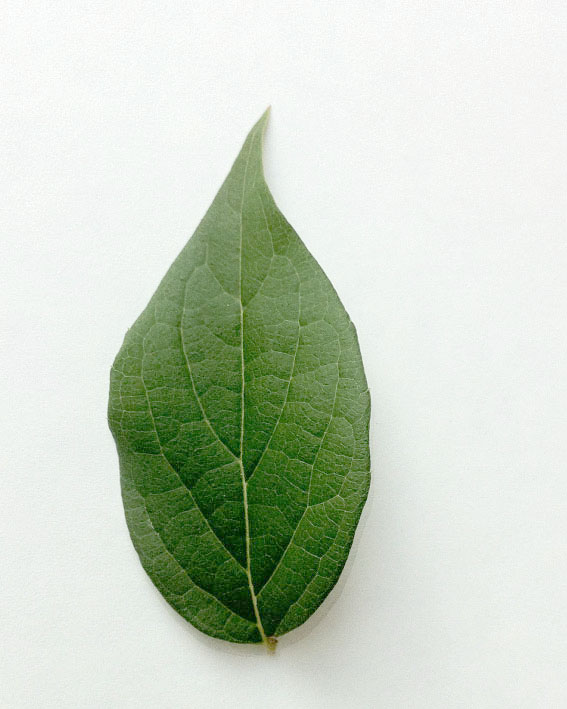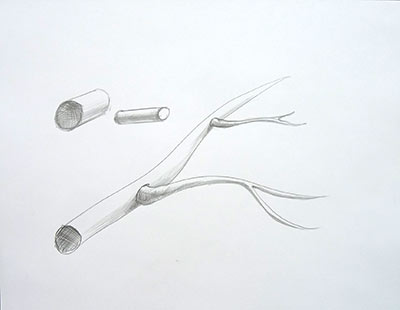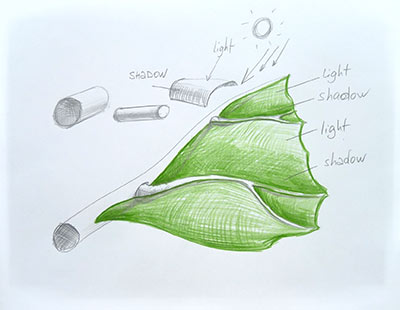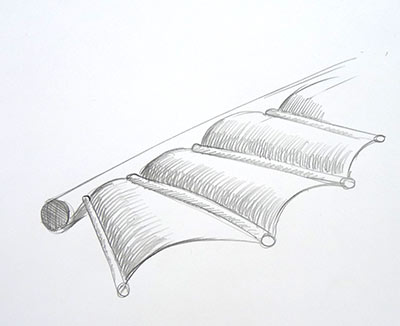by JuliannaKunstler.com
gallery

STEPS

Place a leaf onto a white background (paper).
This way you will not get distracted by other details.

Use a small canvas board or canvas paper, taped to a drawing board.
Draw leaf's stem, outline and major veins.
Use VERY LIGHT and THIN pencil strokes. Harder pencil would work better (H).

Place paints onto your palette.

Use a few drops of Drying retarder over each paint to prevent paints from drying too fast.
Do not use green paint for the leaf. Mix your own custom green that will match your particular leaf. I used:
YELLOW, BLUE, Burnt UMBER and Yellow OCHRE

Apply an "under-painting" layer of watered down dominant color.
Leave gaps where the veins are.
At this point you can add darker values to the areas that are shaded more.

Add a drop shadow to create an illusion that the leaf is actually above the surface.
Start at the edge of the leaf with a dark grey-brown. Use a flat brush - it works best with edging.
Do not just outline the whole leaf. Add shadow only where it is needed. Vary the thickness of the shadow too.
It will make it more alive.
note:
Time to paint white background.
It is very important to define the background and shadows right away because perceive colors and values differently if they are against different backgrounds.

Same Grey looks lighter on the left

Same orange looks brighter and more contrasted on the right
So paint the background at this time - you will get to painting the leaf after that.

Do not forget to add some Drying retarder
These are the colors I used:
Lots of WHITE
YELLOW
BLUE
RED
tiny bit of BLACK (to tone down the colors)
Start with white paint. Add additional colors (just a touch) and start mixing them on the palette. Do not mix them too long.
Apply random loose brush strokes onto canvas. Switch from color to color as you paint - you want to achieve this effect of different tints of white forming a vibrant white background that is full of light.

Paint carefully around the leaf and its shadow.

Some shaded areas can be blended with the background color for a softer look.

Keep some areas more contrasted that others.
Use different values of the shadow.

Background is done.
Let it dry.

Mix your paints for the leaf.
You can also add some WHITE and other colors.

Use another watered down wash to go over the veins. You don't want to keep them white! After all, look at the leaf!
They are NOT white...


Take a closer look at your leaf.
If you were to simplify its structure, what forms would you use?
Stem and veins can be variations of a simple cylinder.
You already know how to shade a cylinder.
Note how the leaf's surface is shaped between the veins.

If you know where the light is coming from - it will become easy to shade the sections of the leaf.
Areas, that face the light source will be lighter, areas that do not get the direct light - will be darker.
Like in this simplified drawing.

Do not outline the veins. Observe them:
- are the veins thick or thin?
- are they darker or lighter than the rest of the leaf?
- how do we see the veins - is it a vein itself or a leaf bends to create an area of contrast where the vein is?
To be continued!

